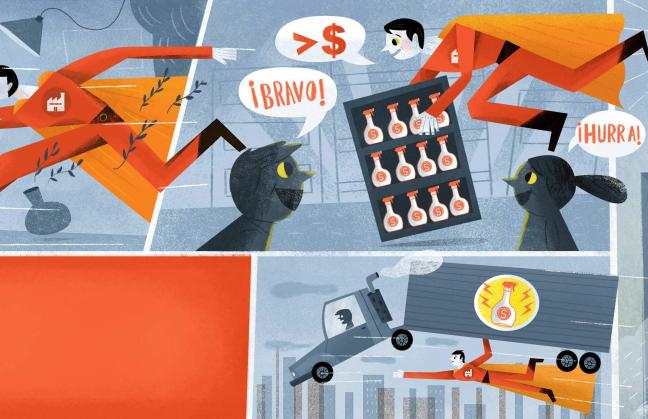Competitiveness Starts with the Value Chain
The logistics gap widens between SMEs and large companies

With increasingly mature, competitive markets, where clients are increasingly better informed and sales channels and suppliers more integrated, companies’ profitability depends to a greater extent on efficient cost management, derived from the value chain.
Logistics and supply chain management not only has a decisive impact on a company’s income statement, but also increases its market penetration and satisfies a greater number of clients by diminishing the number of errors and providing better experiences.
Today’s clients are more demanding: they want top quality consumer goods instantly, with a high level of service and at an affordable price.
Faced with a fluctuating demand, the better prepared and more successful companies are the ones that can minimize product delivery time and offer customers a memorable buying experience. Companies that do not meet customers’ expectations most likely never manage to generate a competitive advantage and a few years after starting operations, will have to close their doors.
How aware are Mexican companies of the importance of managing supply chains efficiently and gaining a competitive advantage in a globalized world?
We asked ourselves this question when we initiated the study “The Supply Chain as the Driver of Competitiveness”, conducted by Logística de México in conjunction with GS1 México and EGADE Business School, based on a survey of 50 companies operating in Mexico, six of which are multinationals, in the automotive (2%), retail (24%), pharmaceutical (8%), consumer (46%), manufacturing (10%), service (8%) and agribusiness (2%) sectors.
The answer found, on completing the study, emphasizes the significant gap existing between the operations of large companies and small and medium-sized enterprise (SMEs). The bigger the company, the more efficient the management of it supply chain.
The study also revealed the potential of companies in Mexico to gain competitiveness, and the enormous areas of opportunity in managing and implementing processes, policies and flows based on best practices.
In-depth analysis of logistics in Mexico
Of the firms who participated in the study, 54% are large companies – with more than 250 employees –, while 46% are SMEs – with less than 250 employees. Compared to the SMEs, the large companies proved to be more committed and better prepared to manage their supply chain efficiently.
Large companies vs SMEs:
- Their executive levels are more involved in (+8%) supply chain design, strategy and management than those of SMEs.
- They are 2.5 times more likely to be efficient, 2 times more likely to be agile and 1.5 times more likely to be flexible, with a greater level of competitiveness in the supply chain.
- They are more likely to outsource or subcontract some of their operations, which implies a greater degree of specialization of the outsourced activities.
- They tend to be 13-17% more concerned about reducing transportation costs, while the SMEs place 9% more importance on remaining close to their suppliers’ facilities.
- 19% of them work with real information, managing the supply chain efficiently, versus 9% of SMEs; 14% of large businesses work under a pull approach, thus simplifying inventory management, reducing storage and transportation costs, in comparison with 9% of SMEs.
- 52% periodically measure production reliability for all their products, in comparison with 27% of SMEs.
- 35% always assess their suppliers’ level of service against 18% of SMEs. The automotive and pharmaceutical sectors place even greater importance on this factor.
- The lack of on-the-shelf products is perceived as a relevant issue for 44% of large companies and for 38% of SMEs.
Best practices for logistical competitiveness
Our study detected shortsighted or deficient practices that diminish companies’ capacity for adaptability and success, such as the lack of decision making based on hard-data analysis, isolated information management, insufficient communication lines or limited incentives for individual performance. These are some of the best practices that could offset many of these deficiencies:
- Chief Operations Officer: The role played by the COO is crucial for the company’s results, focusing on the application and execution of operating guidelines established by management. Executive involvement in supply chain design, strategy and management is critical to guarantee the levels of competitiveness and respond efficiently to any unplanned circumstance.
- Distribution centers: Providing distributions centers with improved infrastructure, optimal processes, cutting-edge technology and specialized talent is indispensable to coordinate the balance between demand and supply. Distribution Centers are characterized by the precise, speedy arrival, storage and release of products in order to achieve high levels of customer service. 85% of companies consider the efficient management of their distribution center’s processes as a source of competitive advantage, with the following aspects as the most important for large companies: location (70%), facility design (53%), performance measurement tools (53%) and processes to measure customer satisfaction (52%).
- Processes and technology: Technology makes it possible to achieve optimized, accessible and profitable distribution networks, information systems that facilitate interconnection and intelligence between personnel and the reduction of operating costs in the long term. However, 73% of SMEs continue to use a traditional structure, compared with 48% of large companies, operating with strict command chains and departmentalization instead of a process-based structure: a boundless organizational chart, with cross functional teams and information flowing.
- Demand planning: The traditional methods (spreadsheets, macros and dynamic tables) are no longer sufficiently practical. Innovation and automated tools are needed to forecast potential demand, such as S&OP (sales and operations planning), collaborative planning, big data analysis, participative forecasting and CPFR (replenishment). While large companies use these methods 1.5 times more than medium-sized companies, very few companies work with Just-in-Time delivery methodologies, which minimize losses, waste and storage costs.
- Sistema ABC System: Solid, integrated strategic planning requires knowledge of the business’s financial indicators, for which the ABC (Activity-Based Costing) system is fundamental, making it possible to assure accurate, reliable real-time information on the unit costs of each activity. This system focuses on the reduction and control of supply chain costs, helping to optimize activities. In spite of the efforts made by large companies to adopt the ABC system, more than half of them still use the traditional methodology.
- Transportation, the key link: The mobilization of raw materials, inputs and finished products represents one of the highest costs within the supply chain and, at times, raises the price of the end product. Therefore, managing transportation efficiently is vital. Of all the companies surveyed, just 23% manage their own fleet; 60% of the multinationals outsource, while only 31% of national companies subcontract a fleet. The potential for improvement is important, since just 30% of the companies evaluate carriers’ performance level.
As can be seen in the study, a comparison of supply chain management in large companies and SMEs reveals numerous differences. There is a wide margin for improvement and for the adoption of best practices in large and small and medium-sized companies alike.
SMEs are on the right path because they clearly understand the importance of improving their supply chain management, but need to progress more decisively to improve the integration of their processes with better technology and the adoption of best practices.



